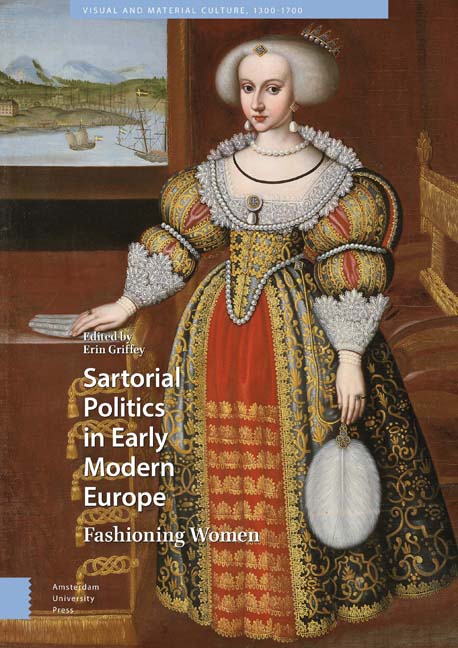Book contents
- Frontmatter
- Acknowledgements
- Contents
- List of Illustrations
- Introduction
- 1 Isabella d’Este's Sartorial Politics
- 2 Dressing the Queen at the French Renaissance Court: Sartorial Politics
- 3 Dressing the Bride: Weddings and Fashion Practices at German Princely Courts in the Fifteenth and Sixteenth Centuries
- 4 Lustrous Virtue: Eleanor of Austria's Jewels and Gems as Composite Cultural Identity and Affective Maternal Agency
- 5 Queen Elizabeth: Studded with Costly Jewels
- 6 A ‘Cipher of A and C set on the one Syde with diamonds’: Anna of Denmark's Jewellery and the Politics of Dynastic Display
- 7 ‘She bears a duke's revenues on her back’: Fashioning Shakespeare's Women at Court
- 8 How to Dress a Female King: Manifestations of Gender and Power in the Wardrobe of Christina of Sweden
- 9 Clothes Make the Queen: Mariana of Austria's Style of Dress, from Archduchess to Queen Consort (1634–1665)
- 10 ‘The best of Queens, the most obedient wife’: Fashioning a Place for Catherine of Braganza as Consort to Charles II
- 11 Chintz, China, and Chocolate: The Politics of Fashion at Charles II's Court
- 12 Henrietta Maria and the Politics of Widows’ Dress at the Stuart Court
- Works Cited
- Index
11 - Chintz, China, and Chocolate: The Politics of Fashion at Charles II's Court
Published online by Cambridge University Press: 21 November 2020
- Frontmatter
- Acknowledgements
- Contents
- List of Illustrations
- Introduction
- 1 Isabella d’Este's Sartorial Politics
- 2 Dressing the Queen at the French Renaissance Court: Sartorial Politics
- 3 Dressing the Bride: Weddings and Fashion Practices at German Princely Courts in the Fifteenth and Sixteenth Centuries
- 4 Lustrous Virtue: Eleanor of Austria's Jewels and Gems as Composite Cultural Identity and Affective Maternal Agency
- 5 Queen Elizabeth: Studded with Costly Jewels
- 6 A ‘Cipher of A and C set on the one Syde with diamonds’: Anna of Denmark's Jewellery and the Politics of Dynastic Display
- 7 ‘She bears a duke's revenues on her back’: Fashioning Shakespeare's Women at Court
- 8 How to Dress a Female King: Manifestations of Gender and Power in the Wardrobe of Christina of Sweden
- 9 Clothes Make the Queen: Mariana of Austria's Style of Dress, from Archduchess to Queen Consort (1634–1665)
- 10 ‘The best of Queens, the most obedient wife’: Fashioning a Place for Catherine of Braganza as Consort to Charles II
- 11 Chintz, China, and Chocolate: The Politics of Fashion at Charles II's Court
- 12 Henrietta Maria and the Politics of Widows’ Dress at the Stuart Court
- Works Cited
- Index
Summary
Abstract
This essay examines the role of female merchants and consumers at the court of Charles II. It explores the complex, commercial interface between courtiers and their suppliers, particularly with regard to acquiring newly fashionable, East-Indian luxuries. The essay examines the 1682 inventory of an unnamed ‘china-woman’ and the valuable range of goods itemized in her warehouse, which included silks, cottons, expensive jewellery, porcelain, teapots, lacquer, and other exotica. The goods held by the merchant reveal a complex supply chain, created and nurtured by merchants, maritime networks, and retailers; further, this challenges the traditional narratives surrounding the introduction of these products into British domestic practices, and the role played by women both at court and in the city.
Key words: Louise de Kerouaille; Barbara Villiers; Catherine of Braganza; China- Women; East India Company; Ben Johnson
In 1687, the East Indies Company wrote to their factors in Bombay asking for, ‘chintzes of all sorts, whereof some to be grave and cloth-coloured, with the greatest variety you can invent, they having become the wear of ladies of the highest quality’ (Figure 11.1). Such requests suggest that the lightweight, colour-fast cotton weaves were rapidly becoming fashionable, and had been easily absorbed into the English market. As Maria Hayward has already shown in the previous chapter, the ladies at the court of Charles II were integral to this trend, as they competed against each other in its observance in the name of fashion. But how did ‘ladies of the highest quality’ agree that these new fabrics were desirable? Who defined and spread these fashions, particularly when supplies might be difficult to obtain? This chapter builds on Hayward's work to show how the fashions that court ladies wore and propagated were determined, not only by the court, but also by structures of colonial exchange, which involved female merchants such as the deceased ‘Testatrix’, whose inventory forms the basis of this study, taking a greater role in sartorial trade than ever before.
In theory, the trajectory should have been straightforward. In a hierarchical society that was supposedly centred on the court, styles should have been set by the elites, facilitated by mercers, haberdashers, and other specialists, before moving out into the countryside and down the social ladder.
- Type
- Chapter
- Information
- Sartorial Politics in Early Modern EuropeFashioning Women, pp. 253 - 276Publisher: Amsterdam University PressPrint publication year: 2019



